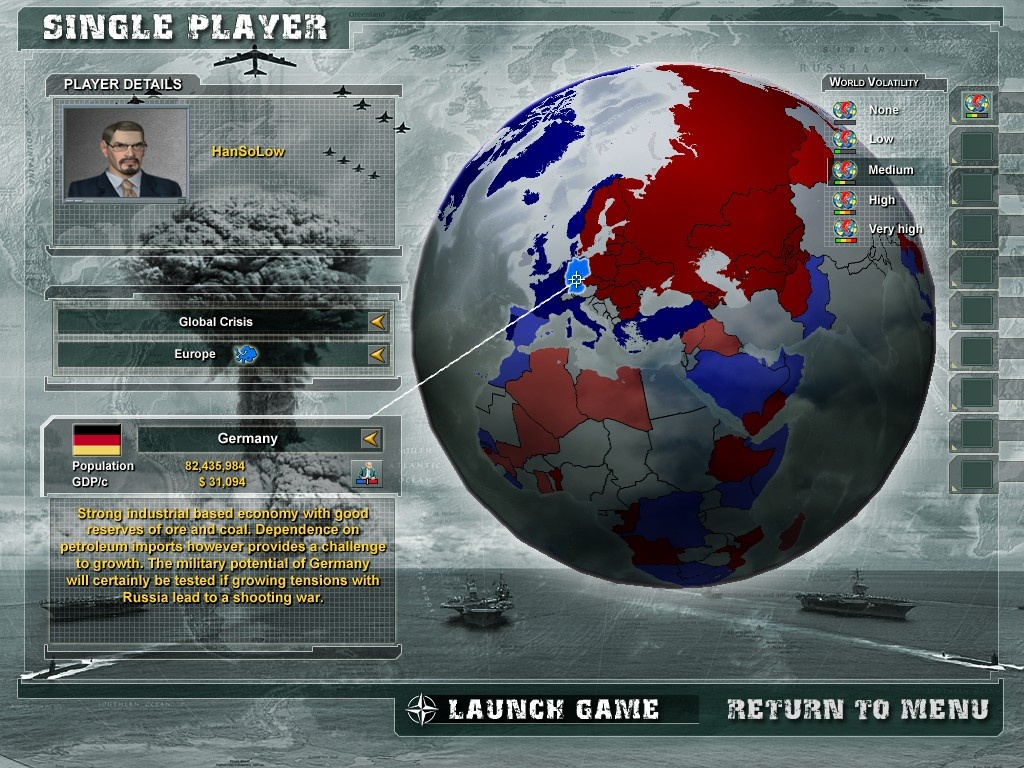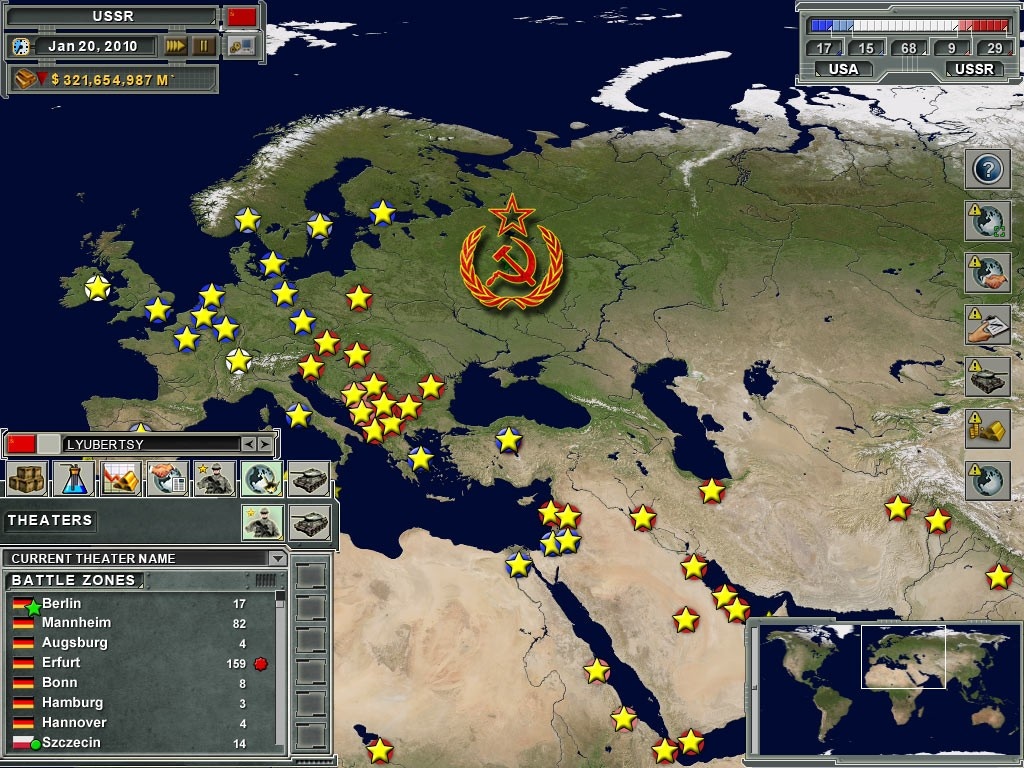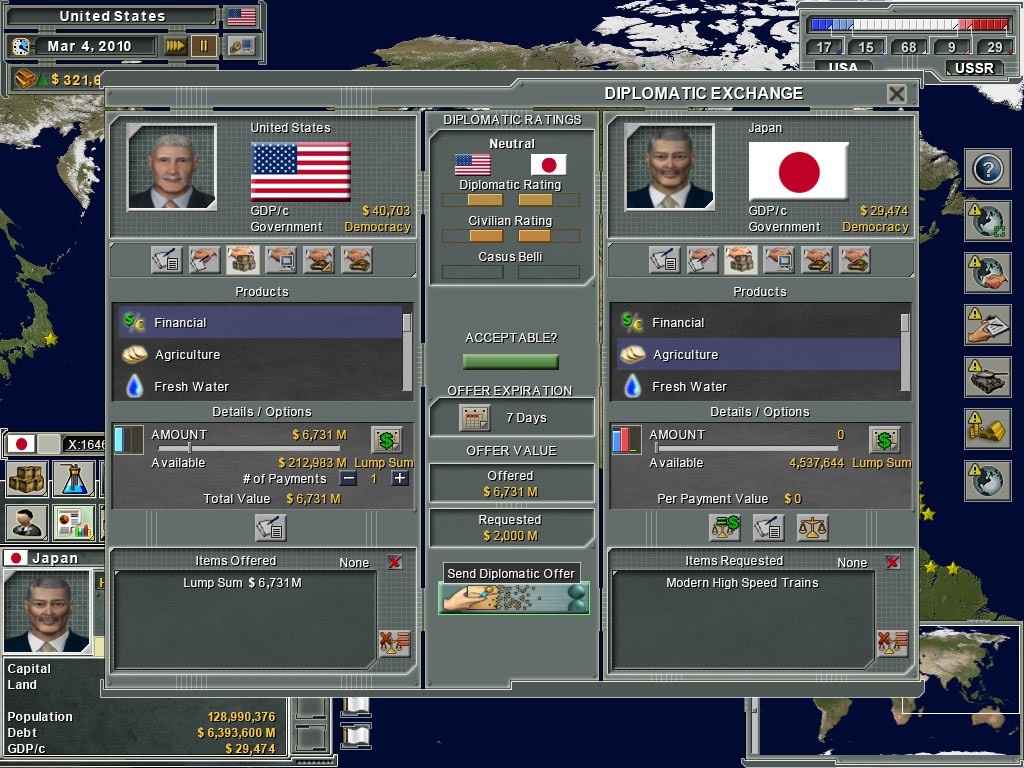Supreme Ruler: Cold War Q&A - First Details
We sit down with lead designer David Thompson to discuss the new changes and features in the next Supreme Ruler strategy game.
The Supreme Ruler grand strategy series puts you in control of a nation and gives you a map that helpfully indicates the territories that you control…and the territories that you don't control yet. The next edition of the game, Cold War, will focus on the titular conflict between the United States and the Soviet Union. BattleGoat Studios lead designer David Thompson explains. 
GameSpot: Give us an overview of Cold War. What are some of the primary improvements that the game will make to the Supreme Ruler series?
David Thompson: Supreme Ruler: Cold War is a geopolitical strategy game wherein players can take control of the United States or the Soviet Union and guide their nation through the turbulent years of recent history--a time when escalating tensions between the two powers could have led to nuclear war.
We've certainly enjoyed making games that have such depth and realism, and that is definitely being maintained in Cold War. However, we thought that instead of a doom-and-gloom near-future experience, it was time to tackle historical events and let players reimagine how they would have done things differently.
As I mentioned before, our game has lots of depth, and the biggest challenge with our previous games was letting players access a plethora of features without making them feel overwhelmed by the user interface. With this in mind, we've revamped the UI to make it more approachable and taken steps to more-quickly immerse players in events as they learn to navigate the game.
Other major improvements to the game include elements that are essential to portray a realistic Cold War scenario, such as more-involved espionage, better diplomatic options, and of course, "spheres of influence," which let players manipulate other countries.
GS: We understand that in the game, players will be able to choose to play as either the US or Russia. Tell us about the two factions. How do they differ from each other?
DT: One advantage of using a historic setting for a game is that most people will already have their own perceptions of the differences between these two superpowers. Ultimately, the biggest difference between the two nations is their political dogma and the methods they employ to influence other nations. The US started with economic aid through the Marshall Plan to keep nations "democratic" and away from the Soviet model, while the public perception of the USSR is that it tended to put tanks in the streets and to arrest political dissenters to keep their own sphere of influence strong. While these perceptions are somewhat accurate, the amount of economic and military aid the USSR pumped into other countries helped solidify relations as well.
The starting point of the campaigns is 1949. This was the point at which the USSR was desperately trying to expand its influence. It was Stalin's opportunity to push for a tight grip on all of Europe and Asia, and never leave Russia at the mercy of another country again. And although the United States was weary of European wars, it had a growing distrust and paranoia of Soviet motives and the growing communist movement worldwide. 
So throughout the campaigns, as you position your country to have a dominant sphere of influence, it is your actions within the "expected character" of your nation that will have the most predictable effects on other nations. Acting "out of character" could have surprisingly good results, or it could spell disaster. And of course, nuclear escalation won't just happen as a result of your own actions--it will also depend on how the other superpower responds.

GS: What other nations are available in the sandbox mode? How do they differ?
DT: One of the most enjoyable aspects of our previous games for many players has been the sandbox mode and how they could decide to play as any nation on Earth and try to take over the world. (I always think of Pinky and the Brain when I talk about this.)
For Cold War, we are definitely keeping the sandbox. Basically, if the country existed as an independent nation in 1949, then you can decide to play as that nation, and although you can't play as a "colony" of another nation, that doesn't mean you won't be challenged by other new independent nations popping up around the world as the years go by.
Obviously, the victory conditions in sandbox might be different from the campaign, and you won't be quite as preoccupied with spheres of influence, but wouldn't it be cool to start as Canada and try and win the space race? (After all, we Canadians had one of the best aerospace programs in the '50s.)
Each nation has its own mix of culture, natural resources, and international relationships. The sandbox mode in our game provides a huge possibility of unique playing experiences since every country is different.
GS: What new changes and additions have been made to sandbox mode?
DT: The sandbox will still have all the new features we're adding for the campaign game, so the types of new actions available are similar. This certainly will let nations try to manipulate one another more without necessarily going to war.
GS: Give us an overview of the combat. How does strategic combat control differ from tactical combat control?
DT: The combat model in our game is tactical. You (or the computer-controlled opponent) position units and move them into combat situations, kilometer by kilometer. Tactics certainly affect the outcome of a battle; after all, you don't send your artillery into close-combat situations. Essentially, this means that you can select any one unit and give it specific orders (like trying to flank an enemy and destroy its rear support units, cutting off its supply). Strategic combat is more akin to other games such as Paradox's Europa Universalis and Hearts of Iron series. You move your units into larger geographic areas, and the combat results are determined based on the total number of units present.
One of the concerns some players have had about our game in the past is the difficulty of managing so many military units at once on a tactical level. Even though we model units on a battalion level, when you're playing as either the US or the Soviet Union, you will literally have thousands of units at your control around the world, and the biggest challenge has been not to lose track of what's going on in various locations and have an opponent unfairly exploit your distractions elsewhere. Don't get me wrong--we have hardcore fans out there that love this about our game, but for the typical player, it can be difficult not to be overwhelmed at times.
To address this, we've added two new geographic designations to the world map: theaters and battle zones. It is now possible to designate which areas of the world you still want to micromanage by maintaining tactical control of units…and which areas you prefer to leave up to your computer-controlled cabinet ministers and generals. Also, you can set up different rules of engagement on a theater or a battle zone level, so your units sitting in North America aren't necessarily at the same alert level and operating under the same rules of engagement as your units in South Vietnam.
GS: How has the diplomatic game been expanded? What else can you do with your neighbors besides invading them?
DT: As I mentioned before, the biggest change to our previous games is the role that "influence" plays. The real key to success in Cold War will not come from invading your neighbor, but instead from influencing them to your way of thinking without going to war. That will be accomplished mainly through diplomatic efforts such as various types of aid and good trade relations, but also through other actions, such as possibly helping an ally discover that it has been infiltrated by spies from another rival country, or by being the first nation to reach a milestone in the space race.
Furthermore, inaction can have just as much effect on your influence as taking action. If you let the USSR put missiles in Cuba without blockading the island, what do you think will happen to your influence levels?
I do want to stress that actually going to war over an issue will not necessarily be a failure (as in a game like Chris Crawford's Balance of Power), but if you do, it will be a good idea to try and limit its scope. Wars have a nasty habit of escalating, and in the era of the Cold War, that could lead to a long, cold nuclear winter. 
GS: Finally, is there anything else you'd like to add about the game?
DT: We've based it on a historical period that was incredibly interesting and diverse. We've also taken a great many steps to make it a more approachable game to learn without "dumbing it down," so hopefully players that would normally consider something like this to be too much of a grognard's game will take a look anyways. They might find that they'd enjoy a game that challenges more than just their trigger finger.
GS: Thank you.
Got a news tip or want to contact us directly? Email news@gamespot.com
Join the conversation